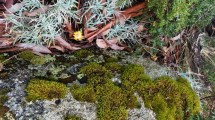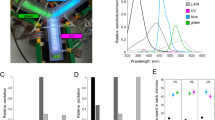Abstract
We studied associative visual learning in harnessed honeybees trained with monochromatic lights associated with a reward of sucrose solution delivered to the antennae and proboscis, to elicit the proboscis extension reflex (PER). We demonstrated five properties of visual learning under these conditions. First, antennae deprivation significantly increased visual acquisition, suggesting that sensory input from the antennae interferes with visual learning. Second, covering the compound eyes with silver paste significantly decreased visual acquisition, while covering the ocelli did not. Third, there was no significant difference in the visual acquisition between nurse bees, guard bees, and foragers. Fourth, bees conditioned with a 540-nm light stimulus exhibited light-induced PER with a 618-nm, but not with a 439-nm light stimulus. Finally, bees conditioned with a 540-nm light stimulus exhibited PER immediately after the 439-nm light was turned off, suggesting that the bees reacted to an afterimage induced by prior adaptation to the 439-nm light that might be similar to the 540-nm light.







Similar content being viewed by others
References
Abel JR, Menzel R (2001) Structure and response patterns of olfactory interneurons in the honeybee, Apis mellifera. J Comp Neurol 437:363–383
Ben-Shahar Y, Leung HT, Pak WL, Sokolowski MB, Robinson GE (2003) cGMP-dependent changes in phototaxis: a possible role for the foraging gene in honey bee division of labor. J Exp Biol 206:2507–2515
Bitterman ME, Menzel R (1983) Classical conditioning of proboscis extension in honeybees (Apis mellifera). J Comp Psysiol 97:107–119
Ehmer B, Gronenberg W (2002) Segregation of visual input to the mushroom bodies in the honeybee (Apis mellifera). J Comp Neurol 451:362–373
Faber T, Joerges J, Menzel R (1999) Associative learning modifies neural representations of odors in the insect brain. Nat Neurosci 2:74–78
Faber T, Menzel R (2001) Visualizing mushroom body response to a conditioned odor in honeybees. Naturewissenschaften 88:472–476
Farooqui T, Robinson K, Vaessin H, Smith BH (2003) Modulation of early olfactory processing by an octopaminergic reinforcement pathway in the honeybee. J Neurosci 23:5370–5380
Farooqui T, Vaessin H, Smith BH (2004) Octopamine receptors in the honeybee (Apis mellifera) brain and their disruption by RNA-mediated interference. J Insect Physiol 50:701–713
Galizia CG, Sachse S, Rappert A, Menzel R (1999) The glomerular code for odor representation is species specific in the honeybee Apis mellifera. Nat Neurosci 2:473–478
Gerber B, Smith B (1998) Visual modulation of olfactory learning in honeybee. J Exp Biol 201:2213–2217
Giger AD, Srinivasan MV (1996) Pattern recognition in honeybees: chromatic properties of orientation analysis. J Comp Physiol A 178:763–769
Giurfa M, Vorobyev MV, Kevan PG, Menzel R (1996) Detection of colored stimuli by honeybees: minimum visual angles and receptor specific contrasts. J Comp Physiol A 178:699–709
Giurfa M, Vorobyev MV, Brandt R, Posner B, Menzel R (1997) Discrimination of colored stimuli by honeybees: alternative use of achromatic and chromatic signals. J Comp Physiol A 180:235–244
Giurfa M, Zhang S, Jenett A, Menzel R, Srinlvasan MV (2001) The concepts of ‘sameness’ and ‘difference’ in an insect. Nature 410:930–933
Giurfa M (2003) Cognitive neuroethology: dissecting non-elemental learning in a honeybee brain. Curr Opin Neurobiol 13:726–735
Giurfa M, Malun D (2004) Associative mechanosensory conditioning of the proboscis extension reflex in honeybees. Learn Mem 11:294–302
Grünbaum L, Müller U (1998) Induction of a specific olfactory memory leads to a long-lasting activation of protein kinase C in the antennal lobe of the honeybee. J Neurosci 18:4384–4392
Guerrieri F, Schubert M, Sandoz JC, Giurfa M (2005) Perceptual and neural olfactory similarity in honeybees. PLoS Biol 3:e60
Hammer M (1993) An identified neuron mediates the unconditioned stimulus in associative olfactory learning in honeybees. Nature 366:59–63
Hammer M, Menzel R (1998) Multiple sites of associative odor learning as revealed by local brain microinjections of octopamine in honeybees. Learn Mem 5:146–156
Hempel de Ibarra NH, Giurfa M (2003) Discrimination of closed coloured shapes by honeybees requires only contrast to the long wavelength receptor type. Anim Behav 66:903–910
Horridge A (2003) Visual resolution of the orientation cue by the honeybee (Apis mellifera). J Insect Physiol 49:1145–1152
Kamikouchi A, Takeuchi H, Sawata M, Ohashi K, Natori S, Kubo T (1998) Preferential expression of the gene for a putative inositol 1,4,5-trisphosphate receptor homologue in the mushroom bodies of the brain of the worker honeybee Apis mellifera L. Biochem Biophys Res Commun 242:181–186
Kamikouchi A, Takeuchi H, Sawata M, Natori S, Kubo T (2000) Concentrated expression of Ca2+/calmodulin-dependent protein kinase II and protein kinase C in the mushroom bodies of the brain of the honeybee Apis mellifera L. J Comp Neurol 417:501–510
Kunieda T, Kubo T (2004) In vivo gene transfer into the adult honeybee brain by using electroporation. Biochem Biophys Res Commun 318:25–31
Kuwabara M (1957) Bildung des bedingten reflexes von Pavlovs Typus bei der Honigbiene, Apis mellifica. J Fac Sci Hokkaido Univ Zool 13:458–464
Lozono VC, Armengaug C, Gauthier M (2001) Memory impairment induced by cholinergic antagonists injected into the mushroom bodies of the honeybee. J Comp Physiol A 187:249–254
Lunney GH (1970) Using analysis of dependent variable: an empirical study. J Educ Meas 7:263–269
Masuhr M, Menzel R (1972) In: Wehner R (ed) Information processing in the visual systems of arthropods. Springer, Berlin Heidelberg New York, pp 315–322
Mauelshagen J (1993) Neural correlates of olfactory learning paradigms in an identified neuron in the honeybee brain. J Neurophysiol 69:609–625
Menzel R, Blakers M (1976) Colour receptors in the bee eye morphology and spectral sensitivity. J Comp Physiol 108:11–33
Menzel R, Backhaus W (1991) The perception of colour. In: Gouras P (ed) Vision and visual dysfunction, vol 6. Macmillan, London, pp 262–293
Mobbs PG (1982) The brain of the honeybee Apis mellifera I. The connections and spatial organization of the mushroom bodies. Phil Trans R Soc Lond B 298:309–354
Mobbs PG (1984) Neural networks in the mushroom bodies of the honeybee. J Insect Physiol 30:43–58
Müller U (1996) Inhibition of nitric oxide synthase impairs a distinct form of long-term memory in the honeybee, Apis mellifera. Neuron 16:541–549
Müller U (2000) Prolonged activation of cAMP-dependent protein kinase during conditioning induces long-term memory in honeybees. Neuron 27:159–168
Müller D, Abel R, Brandt M, Zöckler M, Menzel R (2002) Differential parallel processing of olfactory information in the honeybee, Apis mellifera L. J Comp Physiol A 188:359–370
Neumeyer C (1981) Chromatic adaptation in the honeybee: successive color contrast and color constancy. J Comp Physiol A 144:543–553
Ray S, Ferneyhough B (1997) The effects of age on olfactory learning and memory in the honey bee Apis mellifera. Neuroreport 8:789–793
Ray S, Ferneyhough B (1999) Behavioral development and olfactory learning in the honeybee (Apis mellifera). Dev Psychobiol 34:21–27
Sachse S, Galizia CG (2003) The coding of odour-intensity in the honeybee antennal lobe: local computation optimizes odour representation. Eur J Neurosci 18:2119–2132
Sandoz JC, Galizia CG, Menzel R (2003) Side-specific olfactory conditioning leads to more specific odor representation between sides but not within sides in the honeybee antennal lobes. Neuroscience 120:1137–1148
Stach S, Benard L, Giurfa M (2004) Local-feature assembling in visual pattern recognition and generalization in honeybees. Nature 429:758–761
Takeda K (1961) Classical conditioned response in the honey bee. J Ins Physiol 6:168–179
Takeuchi H, Kage E, Sawata M, Kamikouchi A, Ohashi K, Ohara M, Fujiyuki T, Kunieda T, Sekimizu K, Natori S, Kubo T (2001) Identification of a novel gene, Mblk-1, that encodes a putative transcription factor expressed preferentially in the large-type Kenyon cells of the honeybee brain. Insect Mol Biol 10:487–494
Takeuchi H, Fujiyuki T, Shirai K, Matsuo Y, Kamikouchi A, Fujinawa Y, Kato A, Tsujimoto A, Kubo T (2002) Identification of genes expressed preferentially in the honeybee mushroom bodies by combination of differential display and cDNA microarray. FEBS Lett 513:230–234
Takeuchi H, Yasuda A, Yasuda-Kamatani Y, Sawata M, Matsuo Y, Kato A, Tsujimoto A, Nakajima T, Kubo T (2004) Prepro-tachykinin gene expression in the brain of the honeybee Apis mellifera. Cell Tiss Res 316:281–293
von Frisch K (1967) The dance language and orientation of bees. Harvard University Press, Cambridge
Winston ML (1987) The biology of the honeybee. Harvard University Press, Cambridge
Witthöft W (1967) Absolute Anzahl und Verteilung der Zellen im Hirn der Honigbiene. Z Morphol Oekol Tiere 61:160–184
Zhang S, Srinivasan MV, Zhu H, Wong J (2004) Grouping of visual objects by honeybees. J Exp Biol 207:3289–3298
Acknowledgments
We would like to express our sincere gratitude to Dr. Martin Giurfa (Université Paul Sabatier) for his valuable comments in writing this manuscript and instruction for the statistical analysis. This work was supported by Grants-in Aid from Bio-oriented Technology Research Advancement Institution (BRAIN).
Author information
Authors and Affiliations
Corresponding author
Electronic supplementary material
Rights and permissions
About this article
Cite this article
Hori, S., Takeuchi, H., Arikawa, K. et al. Associative visual learning, color discrimination, and chromatic adaptation in the harnessed honeybee Apis mellifera L.. J Comp Physiol A 192, 691–700 (2006). https://doi.org/10.1007/s00359-005-0091-4
Received:
Revised:
Accepted:
Published:
Issue Date:
DOI: https://doi.org/10.1007/s00359-005-0091-4




